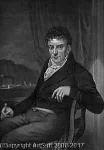Robert Fulton
Robert Fulton
สถานที่: Little Britain
เกิด: 1765
ความตาย: 1815
ชีวประวัติ:
Robert Fulton was an American engineer and inventor who is widely credited with developing a commercially successful steamboat called The North River Steamboat of Clermonts. In 1807 that steamboat traveled by the Hudson River with passengers from New York City to Albany and back again, a round trip of 300 miles, in 62 hours. In 1800, Fulton was commissioned by Napoleon Bonaparte to attempt to design a submarine; he produced the Nautilus, the first practical submarine in history. Fulton is also credited with inventing some of the world's earliest naval torpedoes for use by the British Royal Navy.
Fulton became interested in steam engines and the idea of steamboats in 1777 when he was around age 12 and visited state delegate William Henry of Lancaster, Pennsylvania, who was interested in this topic. Henry had learned about inventor James Watt and his Watt steam engine on an earlier visit to England.
Robert Fulton was born on a farm in Little Britain, Pennsylvania, on November 14, 1765. He had three sisters – Isabella, Elizabeth, and Mary, and a younger brother, Abraham. Fulton's father, Robert, had been a close friend of the father of painter Benjamin West. The younger Fulton later met West in England and they became friends.
Fulton stayed in Philadelphia for six years, where he painted portraits and landscapes, drew houses and machinery, and was able to send money home to help support his mother. In 1785 he bought a farm at Hopewell Township in Washington County for £80 Sterling and moved his mother and family into it. While in Philadelphia, he met a number of prominent figures in the city, including Benjamin Franklin (1705/1706-1790). He was known for both his political and writing abilities and his scientific and inventing knowledge. At the age of 23, Fulton decided to visit Europe.
On January 8, 1808, Fulton married Harriet Livingston (1786–1824), the daughter of Walter Livingston and niece of Robert Livingston, prominent men in the Hudson River area, whose family dated to the colonial era. They had four children: Robert, Julia, Mary, and Cornelia.
Fulton went to England in 1786, carrying several letters of introduction to Americans abroad from the individuals he had met in Philadelphia. He had already corresponded with artist Benjamin West, and West took Fulton into his home, where Fulton lived for several years. Fulton gained many commissions painting portraits and landscapes, which allowed him to support himself. He continued to experiment with mechanical inventions.
He became caught up in the enthusiasm of the "Canal Mania". In 1793 he began developing his ideas for tub-boat canals with inclined planes instead of locks. He obtained a patent for this idea in 1794 and also began working on ideas for the steam power of boats. He published a pamphlet about canals and patented a dredging machine and several other inventions. In 1794 he moved to Manchester to gain practical knowledge of English canal engineering. While there he became friendly with Robert Owen, a cotton manufacturer and early socialist. Owen agreed to finance the development and promotion of Fulton's designs for inclined planes and earth-digging machines; he was instrumental in introducing the American to a canal company, which awarded him a sub-contract. But Fulton was not successful at this practical effort and he gave up the contract after a short time.
In 1797 Fulton went to Paris, where his fame as an inventor was well known. This city and [[London were the scientific centers of the 18th-century European world. There Fulton studied French and German, along with mathematics and chemistry. He began to design torpedoes and submarines. In Paris, Fulton met James Rumsey, who sat for a portrait in West's studio, where Fulton was an apprentice. Rumsey was an inventor from Virginia, who in 1786 ran his own first steamboat up the Potomac River near Shepherdstown, and then in Virginia.
As early as 1793, Fulton proposed plans for steam-powered vessels to both the United States and British governments. In England he met the Duke of Bridgewater Francis Egerton, whose canal, the first to be constructed in Britain, was being used for trials of a steam tug. Fulton became very enthusiastic about the canals, and in 1796 wrote a treatise on canal construction, suggesting improvements to locks and other features.
Working for the Duke of Bridgewater between 1796 and 1799, Fulton had a boat constructed in the Duke's timber yard, under the supervision of Benjamin Powell. After installation of the machinery supplied by the engineers Bateman and Sherratt of Salford, the boat was duly christened Bonaparte in honour of Fulton having served under Napoleon. After expensive trials, because of the configuration of the design, the team feared the paddles might damage the clay lining of the canal and eventually abandoned the experiment. In 1801 the Duke, impressed by Charlotte Dundas constructed by William Symington, decided to order eight of such vessels for his canal. After he died in 1803, the estate executor cancelled the order. Symington had successfully tried steamboats in 1788, and it seems probable that Fulton was aware of these developments.
More...
Wikipedia link: Click Here





